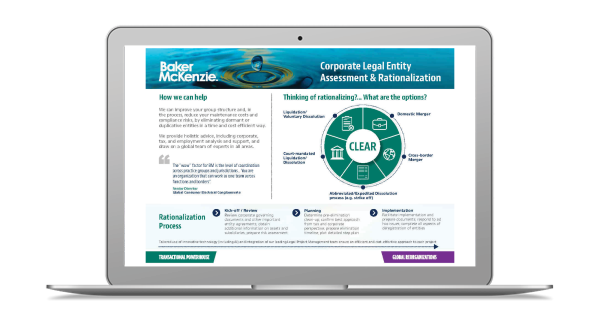How we can help
We can improve your group structure and, in the process, reduce your maintenance costs and compliance risks, by assessing and rationalizing dormant or duplicative entities in a time and cost efficient way. We provide holistic advice, including corporate, tax, and employment analysis and support, and draw on a global team of experts in all areas.
Here we explore why the start of 2021 may be a good time to re-visit plans for dormant entities in your group structures and some of the key benefits that a CLEAR project can bring:
1. CLEAR up time in your day
Maintaining a legal entity, even when it is dormant, will use up valuable resource. Whether it is drafting of corporate approvals, preparation of financial accounts, gathering signatures, making filings, attending to the annual compliance and day-to-day obligations of your dormant legal entities can require a significant amount of management time.
Your central legal team may be tasked with overseeing the corporate governance and maintenance of these dormant entities, and time is likely also being spent by team members in different functions based in local regions/jurisdictions who may oversee specific entities. When you rationalize dormant or unneeded entities, you are freeing up time that will allow you and your team to focus on the parts of your business that truly matter.
2. CLEAR away unnecessary expenses
The potential costs of maintaining a legal entity can add up quickly. When you add up all of the potential expenditures – including the cost of preparing required documents and making required filings associated with annual compliance, the costs of engaging third party directors and/or auditors in some jurisdictions, paying for office space or a registered address, attending to HR and IT costs, it can sometimes be the case that a single legal entity could cost up to USD 50,000 a year to maintain.
When you rationalize dormant or unneeded entities, especially across your entire organizational structure, you can find monetary savings of potentially hundreds of thousands of dollars a year.
3. CLEAR out hidden inefficiencies
Whether your organizational structure has grown organically or through acquisitions, this can create situations where entities are not always organized in their most efficient way.
The elimination of dormant or unneeded entities can allow you to reorganize your organizational structure more generally, which can help you to align better with your overall global holding structure, streamline potential cash repatriation exercises by for example removing potential dividend blocks, create stronger operational efficiencies, or ensure tax optimization.
4. CLEAR aside liability risks and headaches for your executives
Given the responsibilities and obligations that come with being a director or officer of a legal entity, and the potential personal civil or criminal liability that failure to meet routine corporate maintenance obligations such as filing of accounts on time can lead to, it makes sense that you would want to make things easier for the individuals that serve in these roles. As an example, in the UK, failure to file statutory accounts can result in a criminal record for directors.
By rationalizing entities that you do not need anymore, you’re limiting the risk for personnel who are appointed as directors and officers of the entities, giving your senior management greater peace of mind about the group’s legal entity management and governance practices.
5. CLEAR the ground for future acquisitions or divestitures
Whether you already have transformative transactions in mind, or if you are just thinking that you may want to be ready for one, having a streamlined and well-organized corporate structure is a vital piece of any such planning.
By eliminating entities that are no longer needed and proactively taking steps to organize your structure in an efficient way, you improve perception of your group structure by investors or other third parties and can prepare yourself to slot in any new acquisitions or carve out any potential spin-offs.
Please get in touch with our key contacts for more information.




